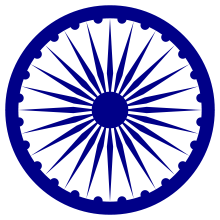National symbols of India
The modern Republic of India has several official national symbols including a flag, an emblem, an anthem, a song as well as several national symbols. All the symbols were picked up at various times. The design of the national flag was officially adopted by the Constituent Assembly just 21 days before Independence, on the 24th of July in 1947.[1] There are also several other patriotic symbols including the national animal, bird, fruit, flower and tree... have all been selected carefully to project the image of India at its best. They are chosen to reflect Indian culture and beliefs and also the positive at - tributes often associated with Indian traditions respectively.[2]
| Part of a series on the |
| Culture of India |
|---|
 |
| History |
| People |
|
Mythology and folklore |
| Cuisine |
| Religion |
|
|
Music and performing arts |
| Sport |
|
Monuments |
|
See also
References
- "National Flag". Government of India. Retrieved 3 March 2014.
- "National Identity Elements of India". knowindia.gov.in.
- Bharat Mata's third temple will be built in Kurukshetra, 5 acres of land will be near Jyotisar
- "Flag Code of India, 2002". Press Information Bureau. Government of India. 3 April 2002. Archived from the original on 20 May 2015. Retrieved 23 November 2014.
- "State Emblem". Know India. Government of India. Archived from the original on 3 March 2016. Retrieved 1 May 2016.
- "Hindus laud Mick Jagger for singing in Sanskrit - Times Of India". Timesofindia.indiatimes.com. 12 August 2011. Retrieved 23 May 2012.
- "Tagore and Jana Gana Mana". Monish R. Chatterjee.
- "Vande Mataram". Bankim Chandra Chatterjee.
- "India Celebrates 63rd Republic Day". Efi-news.com. Eastern Fare. 26 January 2012. Archived from the original on 15 May 2012.
- Khan, Saeed (25 January 2010). "There's no national language in India: Gujarat High Court". The Times of India. Retrieved 5 May 2014.
- Press Trust of India (25 January 2010). "Hindi, not a national language: Court". The Hindu. Ahmedabad. Retrieved 23 December 2014.
- Guha, Ramachandra (10 February 2011). "6. Ideas of India (section IX)". India After Gandhi: The History of the World's Largest Democracy. Pan Macmillan. pp. 117–120. ISBN 978-0-330-54020-9. Retrieved 3 January 2015.
- Hardgrave, Robert L. (August 1965). The Riots in Tamilnad: Problems and Prospects of India's Language Crisis. Asian Survey. University of California Press.
- "Report of the Commissioner for linguistic minorities: 50th report (July 2012 to June 2013)" (PDF). Commissioner for Linguistic Minorities, Ministry of Minority Affairs, Government of India. Archived from the original (PDF) on 8 July 2016. Retrieved 17 September 2016.
- "Flying low; India's flag carrier is in big trouble". The Economist. 21 July 2012. Archived from the original on 23 June 2016. Retrieved 15 October 2016.
- "Don't take 1,000 and 500 Indian rupee notes to Nepal". Rib staff studies. Retrieved 27 October 2014.
- Meghnad Saha Archived 2015-02-23 at the Wayback Machine
- United States. Congress House House Administration (1964). National Flower Or Floral Emblem. U.S. Government Printing Office. p. 47.
- The March of India. 2. 1949. p. 38.
- "National Tree". Govt. of India Official website. Retrieved 26 April 2019.
- "Jackfruit, Breadfruit & Relatives". Know & Enjoy Tropical Fruit. 2012. Retrieved 23 November 2012.
- "National Fruit". Govt. of India Official website. Retrieved 26 April 2019.
- "National Vegetable". Govt. of India Official website. Retrieved 26 April 2019.
- "National Dish". Govt. of India Official website. Retrieved 26 April 2019.
- Guading, Madonna (2009). The signs and symbols bible : the definitive guide to mysterious markings. New York: Sterling Pub. Co. p. 239. ISBN 978-1402770043.
- Nature's Ways Lore, Legend, Fact and Fiction. F+W Media. 2006. p. 37. ISBN 9780715333938.
- "Elephant: The Animal and Its Ivory in African Culture". Fowler Museum at UCLA. Archived from the original on 30 March 2013. Retrieved 24 January 2013.
- Ali, S & S D Ripley (1980). Handbook of the birds of India and Pakistan. 2 (2 ed.). Oxford University Press. pp. 123–126. ISBN 0195620631.
- "Declaration of Gangetic Dolphin as National Aquatic Animal" (PDF). Government of India - Ministry of Environment, Forest and Climate Change. 10 May 2010. Retrieved 23 October 2016.
- "Education for Biodiversity Conservation CoP-11, Hyderabad". Press Information Bureau Government of India. Press Information Bureau Government of India Ministry of Environment, Forest and Climate Change. 18 October 2012. Retrieved 3 May 2019.
The Minister also announced the National Microbe for India which was selected by children who had visited the Science Express Biodiversity Special, a train which has been visiting various stations across the country. Voting for the National Microbe took place in these stations and the children have selected the Lactobacillus (Lactobacillus delbrueckii subsp. bulgaricus) to be the National Microbe for India
- "National River". Government of India. Retrieved 3 April 2012.
- "Largest Library in India - National Library Kolkata".
- "Progress To Be Made In National Library, Kolkata". 16 December 2011.
- "Archived copy". Archived from the original on 7 April 2014. Retrieved 1 April 2014.CS1 maint: archived copy as title (link)
- "About us". Archived from the original on 14 April 2010. Retrieved 18 May 2010.
External links
| Wikimedia Commons has media related to National Symbols of India. |
- List of National Symbols of India
- National Symbols Govt. of India Official website.
- National Symbols of India
This article is issued from Wikipedia. The text is licensed under Creative Commons - Attribution - Sharealike. Additional terms may apply for the media files.
